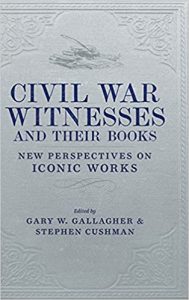Book Review: Civil War Witnesses and Their Books: New Perspectives on Iconic Works
 Civil War Witnesses and Their Books: New Perspectives on Iconic Works
Civil War Witnesses and Their Books: New Perspectives on Iconic Works
Edited by Gary W. Gallagher & Stephen Cushman
Louisiana State University Press 2021 $45 hardcover
Reviewed by Sean Michael Chick
If there are two things we seem assured to see, it is an essay collection edited by Gary W. Gallagher and a book on Civil War memory. The latest entry, also edited by Stephen Cushman, is Civil War Witnesses. It purports to offer new prospective on iconic works. It succeeds in the former, but less in the latter since most of these works are not iconic. A few are even rather obscure comparatively, and the degree to which they are “new perspectives” can be debated. There is so much literature on the war, and so much of it is drenched in partisanship and/or conforming to the various memories of the conflict, what one can hope is that these narratives are treated with more nuance than is increasingly standard fare today.
There are eight essays here written by notable scholars, with five of the eight being about Union sources. Among the eight we get two generals, a Massachusetts politician, a New York socialite, the wife of a Union general, a Confederate nurse, a Union soldier, and a Confederate officer who did not make the rank of general. While the introduction admits that there are few black voices, overall in terms of sex and experience of the war it is a diverse selection.
Among my favorites is Sarah E. Gardner’s essay on Phoebe Yates Pember’s nurse narrative. This is an essay of nuance, showing how Pember considered her audience in her literary decisions. One would never know she was Jewish, for instance, although it is clear enough in her letters. The same can be said for my favorite piece, which is about George McClellan. Cushman offers a good read and one that is fair and takes a measured view of McClellan. He comments on aspects of the general and his memoirs often absent in other treatments, such as his strong faith. This essay is a pleasure and contains interesting insights that go beyond the stale anti-McClellan bias. Both Cushman and Gardner rely on a close reading of the texts, and that makes a big difference.
A close second is M. Keith Harris’ take on John D. Billings, the Union artillerist who wrote Hardtack and Coffee. Harris points out something I noticed years back and almost wrote a dissertation on. Federal soldiers and generals might concede that the Confederates fought hard, but they were adamant in their belief that theirs was the righteous cause. What that cause was might vary of course, as shown in Cecily N. Zander’s look at Elizabeth Bacon Custer. She ably argues that Custer left valuable sources that have been neglected. Custer emphasized Union over slavery as the driving force. In that way Zander and Harris support the emerging argument that the drive for reconciliation, as David Blight described it, was more from civilians than the soldiers.
These are my favorite essays, but none of the rest are bad. J. Matthew Gallman’s piece on Maria Lydig Daly’s diary is a fair assessment and summary of an important source. Gallagher’s work on Walter Taylor is solid and even-handed in its treatment of Taylor’s strengths and weaknesses as a source. Elizabeth R. Varnon tackles James Longstreet in a well-written essay about a general trying to set the record straight, snipe at enemies, and repay Grant for his friendship. Perhaps the best part is her contention that Longstreet had allies in the South, even among Democrats with whom he agreed on economic issues in Georgia. Yet one must still conclude Longstreet’s memoirs failed to win him many more friends, particularly as he thought Grant was Robert E. Lee’s superior as a general and a man. That being the standard academic view today, one can surmise Longstreet did better in that battle than he did at Fort Sanders.
The only frustrating essay is the second in the book, covering Henry Wilson, the abolitionist senator who wrote a three-volume tome that worked as autobiography and history. William A. Blair notes that the history confirms well to most current scholarship, save where Wilson is not progressive enough, such as misunderstanding how many Southern whites were committed to slavery and concentrating on the work of white male abolitionists. This essay is well written, but misses the point that if contemporary scholarship mostly mirrors not just the Republican Party, but one particular faction of that party, then its focus is at heart narrow. Furthermore, it puts a lie to the idea that the current turn in scholarship is wholly original. Blair’s essay is not bad, it just does not engage its subject with as much insight as the others. Being fair to Blair, few works discussed are as daunting as Wilson’s doorstopper and Blair is best at describing Wilson’s narrative, intent, and how the work was received upon publication.
I sometimes fear current scholarship will in time morph into simply Wilson’s Rise and Fall of the Slave Power, updated edition. Instead, I found Civil War Witnesses to be refreshing. It is good to see works that do not read like partisanship. It makes one hopeful.

Sorry Grant is not Lee’s superior as a General. He may be his equal. He certainly is not Lee’s superior as a man.
Thanks for your kind words, Sean!
Glad you enjoyed the essay – thanks much!